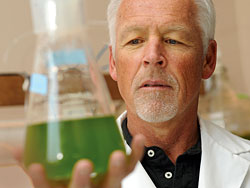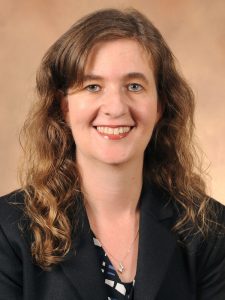
ASU receives U.S. Department of Energy award for algae biofuel research


Peter Lammers is leading a team of Fulton Schools researchers that will share a $2 million award from the U.S. Department of Energy to fund work on innovative solutions to yield more in algae biofuel research. Photographer: Jessica Hochreiter/ASU.
An Arizona State University research team will seek to significantly increase yields of algal biomass feedstock to ramp up production of biofuels as part of a multi-university project supported by a recently awarded $2 million grant from the Bioenergy Technologies Office in the U.S. Department of Energy.

Peter Lammers
Peter Lammers, a research professor with Arizona Center for Algal Technology and Innovation, leads the team that will share funding from the grant with collaborators at New Mexico State University, Colorado State University and the National Renewable Energy Laboratory. AzCATI, which serves the algae industry and research community alike as a national testbed for research and commercialization of algae-based products ranging from biofuels to pharmaceuticals, is embedded within the Fulton Schools of Engineering.
Researchers will evaluate mixotrophic metabolism in algae that consume both carbon dioxide and waste sugars derived from plant cellulose. They’ll use a heat-tolerant algae strain isolated from Yellowstone National Park that is perfectly adapted to growth in closed bioreactors that reduce evaporative water loss — which is critical for deployment of the technology in the arid southwestern United States.
Researchers see potential for multiplying algal production rates by five times over current rates. That achievement would significantly reduce the cost of enclosed algal cultivation systems and boost production particularly in in the southwestern United States.

Rosa Krajmalnik-Brown
Rosa Krajmalnik-Brown, an associate professor of civil and environmental engineering in the Fulton Schools, will utilize her expertise and the facilities at ASU’s Swette Center for Environmental Biotechnology to identify all microbes that are able to grow in the production system and describe the full suite of metabolic reactions occurring in the mixotrophic, waste-to-energy process.
Algal feedstock production platforms specifically designed for scale-up on land with limited water resources remain a big gap in the Bioenergy Technologies Office algae research and development portfolio.
The majority of previous algae cultivation studies utilized open-pond cultivation systems that use too much water for deployment in arid regions, but also struggle with culture stability and productivity in outdoor scale-up trials.
As a result, abundant flat land in the Southwest plays little or no role in current DOE resource assessments. Still, the region offers significant potential for algal biofuels that would not compete with food production if water-scarcity challenges can be overcome.
“Water is required in large quantities to grow algae and yet water is in very short supply here,” Lammers says.
“Our production systems avoid evaporation through the use of enclosed systems. These heat up in the sunlight via the greenhouse effect, so we use algae that evolved in hot springs that thrive under the conditions found in our enclosed photobioreactors,” he says. “Our work will evaluate ways to reduce the energy requirement for algae biomass cultivation beyond eliminating the cooling requirement, as we seek to reduce the energy requirements for mixing as well.”
Energy and fertilizer extraction from the algal biomass is accomplished through a process called hydrothermal liquefaction, which works like a pressure cooker to produce a bio-crude oil that can be upgraded to liquid transportation fuels or a natural gas substitute through a process called catalytic hydrothermal gasification.
The bioenergy technology grant is one of six awarded to projects nationwide. ASU Foundation Professor Wim Vermaas with the School of Life Sciences also received an award, giving the university a third of the grants to fund development of innovative solutions to producing more bioenergy. David Nielsen, an associate chemical engineering professor, was a co-PI on the second award.
The program supports the work of the Bioenergy Technologies Office to develop renewable and cost-competitive biofuels from non-food biomass feedstock.
The funding will also support the development of a more robust bio-economy, to create green jobs, spur innovation and provide environmental services while achieving national energy goals.
Media Contact
Erik Wirtanen, [email protected]
480-727-1957
Ira A. Fulton Schools of Engineering



































